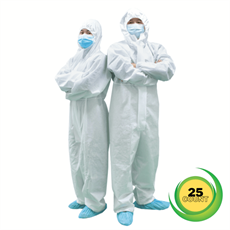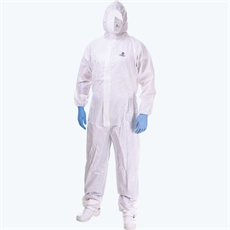The choice of materials for surgical gowns is a critical consideration, as these gowns play a vital role in maintaining a sterile environment during medical procedures while providing comfort and protection to healthcare professionals. Here’s what you should know about surgical gown materials:
- Non-Woven Materials:
- Non-woven materials are commonly used for disposable surgical gowns.
- These materials are made by bonding together fibers using heat, chemicals, or mechanical processes.
- Non-woven fabrics are lightweight, breathable, and cost-effective.
- Common non-woven materials used include polypropylene, polyethylene, and polyurethane.
- They provide a barrier against liquids and particulate matter.
- Woven Materials:
- Woven materials, such as cotton or cotton blends, are used for both disposable and reusable surgical gowns.
- Cotton gowns are comfortable and have been used historically.
- Woven materials are durable but may require more maintenance and sterilization compared to disposable non-woven gowns.
- SMS Fabric (Spunbond-Meltblown-Spunbond):
- SMS fabric is a popular choice for disposable surgical gowns.
- It consists of three layers: a spunbond outer layer, a meltblown middle layer, and another spunbond inner layer.
- SMS fabric is lightweight, breathable, and fluid-resistant.
- The meltblown layer provides excellent filtration and barrier properties.
- Polyester and Polyethylene Coated Materials:
- Some surgical gowns have a polyester or polyethylene coating to enhance fluid resistance.
- These coatings can provide an additional layer of protection against fluids and contaminants.
- Breathability:
- Breathability is a crucial factor in surgical gown materials. Healthcare professionals need to stay comfortable during long procedures.
- Breathable materials help manage heat and moisture, reducing discomfort.
- Fluid Resistance:
- Surgical gowns must provide a barrier against blood, bodily fluids, and other contaminants.
- The level of fluid resistance can vary depending on the gown’s material and design.
- Antimicrobial Properties:
- Some surgical gown materials are treated with antimicrobial agents to reduce the risk of bacterial contamination.
- Antimicrobial gowns can be especially useful in high-risk settings.
- Comfort and Mobility:
- Surgical gowns should allow for ease of movement and be comfortable to wear for extended periods.
- The choice of materials, along with gown design, impacts comfort and mobility.
- Environmental Impact:
- There is growing concern about the environmental impact of disposable medical products, including surgical gowns.
- Some manufacturers are developing eco-friendly disposable gowns or reusable gowns to reduce waste.
- Regulatory Compliance:
- Surgical gowns should meet regulatory standards and guidelines for performance, safety, and quality.
- In the United States, the Food and Drug Administration (FDA) regulates surgical gown materials and performance.
In summary, surgical gown materials are chosen based on their ability to maintain sterility, provide protection, offer comfort, and meet regulatory requirements. The selection of materials may vary depending on whether the gown is disposable or reusable and the specific needs of different medical specialties and procedures. Healthcare facilities must carefully consider these factors when choosing surgical gowns to ensure the safety and well-being of both patients and healthcare professionals.























